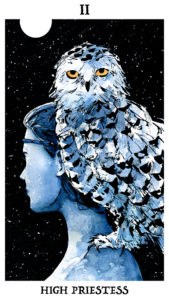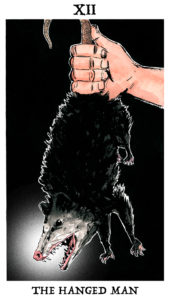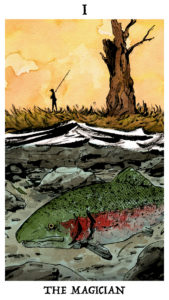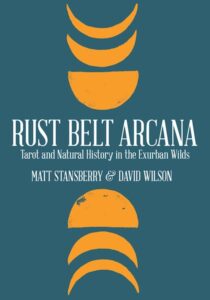There are a wide variety of reasons people become involved with tarot. For some, it’s good, old-fashioned fortune-telling, while others see it as intellectually representational of psychological archetypes. Then there are those who simply enjoy the aesthetic experience of pondering the intricate, symbolically representative artwork that has been worked into the cards by various artists over the centuries, while others follow practices that incorporate them into contemplative, meditative exercises intended to help them examine aspects of their respective lives that might be presently perplexing them. Of course, a mixture of two or more of these is not at all uncommon. However among all those whom I have known, or about whom I have read, who in one way or another incorporate tarot into their lives, Matt Stansberry is unique. However before delving into just how Mr. Stansberry’s use and interpretation of tarot differs from all those about which I’ve previously encountered, a few words about just what tarot is would seem to be in order.
 A standard tarot deck is composed of seventy-eight cards. The minor arcana is a collection of four suits – cups, swords, pentacles, and wands – each numbered from one to ten followed by “face cards,” sometimes also called the royal arcana, of page, knight, queen, and king. To this point the similarity to modern playing cards is clearly apparent; however the addition to the deck of the major arcana is where things get particularly interesting. The twenty-two cards of this group, which includes The Fool, are all emblematic and richly symbolic. Such popularly iconic cards as The Hermit, The Hanged Man, and The Magician are all part of this group, each of which, according to tarot lore, represents archetypes far more complex and nuanced than what might be initially assumed.
A standard tarot deck is composed of seventy-eight cards. The minor arcana is a collection of four suits – cups, swords, pentacles, and wands – each numbered from one to ten followed by “face cards,” sometimes also called the royal arcana, of page, knight, queen, and king. To this point the similarity to modern playing cards is clearly apparent; however the addition to the deck of the major arcana is where things get particularly interesting. The twenty-two cards of this group, which includes The Fool, are all emblematic and richly symbolic. Such popularly iconic cards as The Hermit, The Hanged Man, and The Magician are all part of this group, each of which, according to tarot lore, represents archetypes far more complex and nuanced than what might be initially assumed.
It is this smaller, emblematic major arcana that Matt Standberry takes as one of the twin themes in Rust Belt Arcana; Tarot and Natural History in the Exurban Wilds – the other, of course, is nature; specifically, the natural world of the U.S. state of Ohio and its surrounding region. As might be assumed in an area that has long been famous for its heavy industries, and the more recent deterioration of large segments of those industries and the subsequent social disruptions this deterioration has caused, the state of the natural world Mr. Stansberry describes is one fraught with challenges. This is where his unique application of the tarot’s major arcana comes into play.
 Rust Belt Arcana is a collection of twenty-two relatively short, superbly-written essays, each taking one card from the major arcana as its title, and building upon the reflections of an element of the natural world – or a significant challenge to it – that Mr. Stansberry has found within its accumulated lore. The Fool is paired with the story of a young Black Bear reaching the age of being too old for its natal den and needing to find its own way in a human-modified world. The Tower is a meditation upon the problem of light pollution and buildings to migrating birds. The Hanged Man considers the life history and astonishing resilience of the Virginia Opossum.
Rust Belt Arcana is a collection of twenty-two relatively short, superbly-written essays, each taking one card from the major arcana as its title, and building upon the reflections of an element of the natural world – or a significant challenge to it – that Mr. Stansberry has found within its accumulated lore. The Fool is paired with the story of a young Black Bear reaching the age of being too old for its natal den and needing to find its own way in a human-modified world. The Tower is a meditation upon the problem of light pollution and buildings to migrating birds. The Hanged Man considers the life history and astonishing resilience of the Virginia Opossum.
Using each card as a gateway into deeper reflections upon his experiences with the natural world he very clearly loves, as well as with people he has met who are working to protect aspects of it that are at risk from continued human encroachment upon it, Mr. Stansberry offers a fusion of the scientific with the spiritual that is truly refreshing. As a result of this “going deeper” into his subjects, he is able to present them in fresh and remarkably insight-filled ways that have the power to inform, inspire, and motivate his readers.
 Not only are the essays reflections upon each of the major arcana’s cards, the cards depicted at the beginning of each chapter are visual representations of the essays. Created by artist David Wilson, this rust belt major arcana is a brilliant merging of Mr. Stansberry’s writings with traditional tarot symbolism. In fact, as one who has long struggled to acquire some understanding of tarot myself, only to become lost in explanations of symbolism I often just can’t quite manage to see in many of the traditional card designs, Mr. Wilson’s artwork – paired with Mr. Stansberry’s reflections upon the subjects – bring the archetypes and their interpretations to life in ways that resonate deeply with me, as I suspect they also will to many who find inspiration, motivation, and both intellectual as well as spiritual insight in nature. (In fact, not only did Mr. Wilson create a complete set of the major arcana to serve as illustrations for the book, he created a complete tarot deck upon the larger theme established in its pages.)
Not only are the essays reflections upon each of the major arcana’s cards, the cards depicted at the beginning of each chapter are visual representations of the essays. Created by artist David Wilson, this rust belt major arcana is a brilliant merging of Mr. Stansberry’s writings with traditional tarot symbolism. In fact, as one who has long struggled to acquire some understanding of tarot myself, only to become lost in explanations of symbolism I often just can’t quite manage to see in many of the traditional card designs, Mr. Wilson’s artwork – paired with Mr. Stansberry’s reflections upon the subjects – bring the archetypes and their interpretations to life in ways that resonate deeply with me, as I suspect they also will to many who find inspiration, motivation, and both intellectual as well as spiritual insight in nature. (In fact, not only did Mr. Wilson create a complete set of the major arcana to serve as illustrations for the book, he created a complete tarot deck upon the larger theme established in its pages.)
Of all the books I have read on the subject of natural history, and particularly of those I’ve read touching upon deep ecology and nature-base spirituality, as well as works on the history and practice of tarot itself, I have never been so previously fortunate as to read such a perspective-enlarging, mind-expanding work as Rust Belt Arcana. The observations and insights contained in its collected essays, as well as its sometimes playful, sometimes serious, always evocative imagery, left me feeling both more concerned about the state of the natural world as well as more committed to perceiving its myriad wonders in ways that encourage me to live more respectfully and responsibly upon this planet. I strongly suspect it will have a similar effect upon others, and I highly recommend it to any and all who are interested in discovering both new information about the natural world as well as new ways to contemplate and understand it.
 Title: Rust Belt Arcana; Tarot and Natural History in the Exurban Wilds
Title: Rust Belt Arcana; Tarot and Natural History in the Exurban Wilds
Author: Matt Stansberry, illustrations by David Wilson
Publisher: Belt Publishing
Format: Paperback
Pages: 160 pp.
ISBN-13: 978-1948742122
Published: October 2018
In accordance with Federal Trade Commission 16 CFR Part 255, it is disclosed that the copy of the book read in order to produce this review was provided gratis to the reviewer by the publisher.
If you enjoyed reading this, please consider signing up for The Well-read Naturalist's newsletter. You'll receive a helpful list of recently published reviews, short essays, and notes about books in your e-mail inbox once each fortnight.

